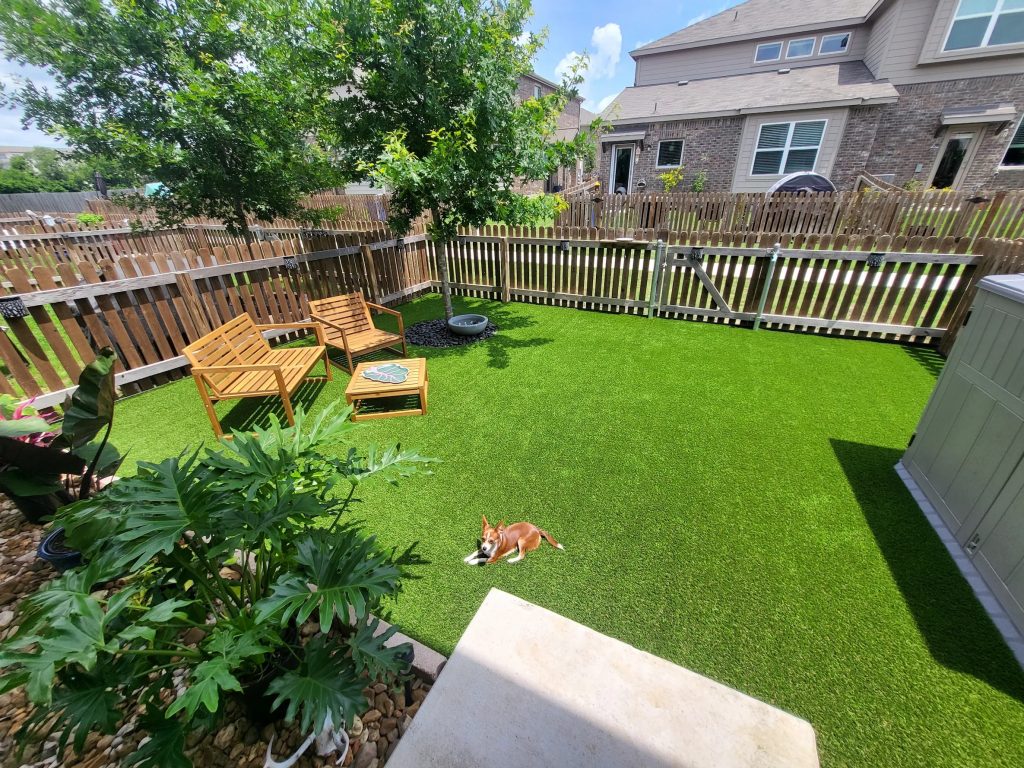For homeowners, pet lovers, and even doggy daycares, a lush yard is meant to be a space of comfort and play, not stress, mess, and hidden dangers. But with a traditional grass lawn comes a minefield of common hazards that can put pets, children, and your peace of mind at risk. The good news is that installing pet-friendly turf can eliminate those hazards entirely.
Whether you’re a homeowner with a playful golden retriever, a veterinarian looking to upgrade your outdoor spaces, or a dog park manager tasked with creating a clean, low-maintenance play zone, this post is for you.
Quick Summary: What pet turf helps prevent
- Fleas, ticks, and lawn-borne illnesses
- Exposure to toxic lawn chemicals
- Mud, puddles, and standing water
- Physical dangers like holes or sharp debris
- Urine burn spots and pet-induced lawn damage
- Seasonal allergens like grass pollen and mold
Why your yard might not be as safe as you think
Natural grass has its appeal, but it’s also full of potential risks. Traditional lawns can trap bacteria, encourage pests, camouflage snakes or hazardous debris, and retain moisture, creating ideal conditions for parasites and diseases.
For pet owners, this can mean vet visits, yard repairs, and a whole lot of hassle. You may not notice anything until your pet comes back inside, scratching, limping, unexpectedly wet, or even getting sick.
Especially relevant for pet-focused commercial spaces
These concerns apply just as much to pet-centric businesses as they do to homeowners. Doggy daycares, veterinary clinics, apartment complexes, and public dog runs face the same challenges, only magnified by high foot (and paw) traffic.
That’s why pet-friendly turf is becoming a preferred solution for facilities and families alike, who are looking to balance hygiene, durability, and comfort.
Pet-friendly turf eliminates these common yard hazards
1. Parasites, bacteria & insects
The Problem:
Traditional lawns can harbor fleas, ticks, roundworms, and harmful bacteria—especially in areas with pet waste, standing water, or decaying plant matter.
The Turf Advantage:
Synthetic turf breaks the life cycle of pests by eliminating their natural habitat. With no soil to nest in and fast-drying surfaces, pests can’t thrive. Pet-friendly turf systems mean no more tedious tick checks after outdoor time, and adding antimicrobial infill can reduce bacterial buildup from pet waste.
2. Chemical exposure (fertilizers, herbicides, & pesticides)
The Problem:
To keep real grass green, most homeowners rely on a cocktail of fertilizers, weed killers, and pest control chemicals, many of which are toxic to pets and kids.
The Turf Advantage:
Pet turf doesn’t require chemical treatments. No fertilizers, no pesticides, no worry. It’s a clean, chemical-free zone where your pets can run and play safely.
3. Mud, puddles, and standing water
The Problem:
After a rainstorm or even just a heavy watering, natural grass turns into a muddy mess. Dogs dig, run, and track that mess straight into your home or facility.
The Turf Advantage:
Synthetic turf is permeable, allowing water to pass through quickly. That means dry surfaces, clean paws, and no lingering insects.
4. Physical hazards (holes, rocks, and sharp objects)
The Problem:
Uneven terrain, loose rocks, or holes dug by pets can cause injuries from punctured paws to torn ligaments and broken bones.
The Turf Advantage:
Pet-friendly turf provides a consistent, level surface that keeps sharp or hazardous debris easy to spot and remove. It’s ideal for energetic pets, seniors, and even toddlers.
5. Burn spots, bare patches, and other pet damage
The Problem:
Dog urine contains nitrogen, which burns grass and creates dead spots. Add digging or running trails on top of frequent potty spots, and your once-beautiful yard turns into a patchy disaster.
The Turf Advantage:
Pet-friendly turf (paired with the right infill) is unaffected by pet urine and won’t develop brown spots. It’s easy to rinse off and remains green and intact, even in the most high-use areas.
6. Allergies and seasonal issues
The Problem:
Grass pollen, mold, and fungal spores can aggravate allergies in both pets and their owners.
The Turf Advantage:
Synthetic turf eliminates pollen and doesn’t retain moisture like real grass, reducing allergen exposure throughout the year.

Who benefits most from pet-friendly turf?
Homeowners
Enjoy a spotless yard with no muddy paw prints, brown patches, or hidden hazards. Pet-friendly turf means less cleaning, fewer yard chores, and more carefree playtime for the whole family.
Pet Daycares & Clinics
Keep your facility cleaner and safer for pets and staff. Turf reduces mess, resists urine spots, and offers a consistent, paw-friendly surface—so you spend less time cleaning and more time caring.
Apartments & Parks
Shared spaces stay green, clean, and mud-free all year. Turf reduces maintenance costs, stays usable after rain, and gives every resident and their pet a reliable place to play.
Is turf safe for pets? What to look for
Not all synthetic grass is created equal. Here’s what to look for when choosing turf for pet applications:
- Non-toxic materials: Avoid turf with lead or heavy metals. Ask your turf installer for specific product manufacturer information.
- Antimicrobial infill: This add-on reduces odor and bacteria and is perfect for households with multiple pets.
- Heat-resistant fibers: Keep paws cooler in the sun with turf products designed to dissipate heat.
- Certified safety standards: Third-party tested turf is always best. Request certified lab results from your turf installer.
Lone Star Turf installs premium turf systems that exceed safety benchmarks and are specifically designed for pet comfort, sanitation, and longevity.
FAQ
What is pet-friendly turf?
Artificial turf is designed to be safe and durable for pets. It is made from lead-free and non-toxic materials, and can include antimicrobial infill for additional protection.
Is artificial grass safe for dogs?
Yes. Quality pet turf is lead-free, heat-resistant, and hygienic when properly maintained.
How do I clean turf for pets?
Remove visible debris by hand or using a leaf blower. For a deeper clean, or if a pet was sick, give it a quick rinse with a hose.
Does artificial turf smell when you have dogs?
If cleaned consistently, no. Antimicrobial infill can minimize stinky buildup, and occasionally spraying your turf with a pet-safe enzyme cleaner like Simple Green can provide added odor control.
Is pet-friendly turf worth the investment?
Yes, especially for pet owners or high-traffic areas. Reduced maintenance, cleaner surfaces, and fewer vet visits add up to long-term savings. Most homeowners see full ROI within 3-5 years.
Safety without sacrifice
Your yard should be a haven, not a hazard. With pet-friendly turf, you eliminate the hidden dangers of natural lawns while creating a cleaner, safer space for your pets and family. From health and hygiene to durability and design, turf provides a worry-free outdoor solution that lasts for years.
Ready to upgrade your yard or facility?
Reach out to Lone Star Turf today for a free quote and learn how we can help you install a safer, smarter space for your pets and the people who love them.
Eager to learn more about artificial turf for your pets? Check out our Complete Guide to Fake Grass for Pets.
